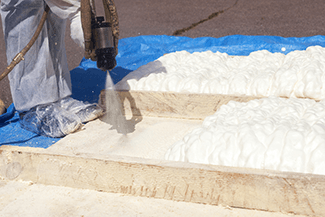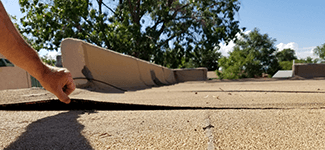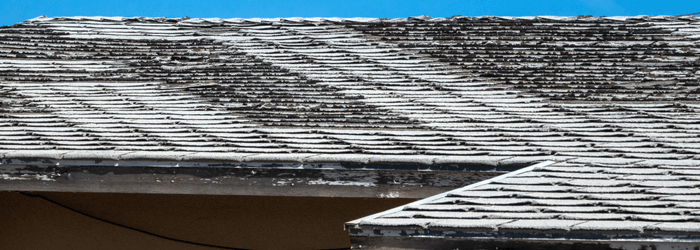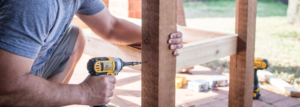Just as with Part 1, where we discussed the individual strengths and weakness of concrete tile and single roof systems and how to mitigate them, Tyler Johnson, Johnson Roofing, a Rosie-Certified Partner explains the differences between flat roof systems, here, in Part 2.
Head over to part 1 for information on Concrete & Shingle roofing types.
Flat Roofs
There are many types of flat roofs used in Arizona. The majority are commercial and many of the types of flat roofs on residential houses are scaled down versions of a commercial roof system. Many times, people complain about their flat roofs, and it is almost always a direct result of the “scaling down” on the roof system to save cost that has resulted in issues. A typical residential flat roof has a life expectancy of less than 20 years. It is all about how much money you are willing to put into your house.
The most common residential flat roofs:
Foam:

By far the most common flat roof on houses in Arizona, it is composed of two different components that are mixed on your roof and installed. This results in a “seamless” roof and adds insulation value to your house. A foam roof will outlast just about any other roof out there. It is not uncommon for foam roofs to last 50 years. However, it does require an extensive amount of maintenance. Foam is one of the hardest roof systems to install. Below are a few of the issues that you might face with a foam roof.
- Coating Thickness: Foam is a great water-proofer, but it has one major enemy — UV Degradation. Sunlight will turn it to dust in a matter of days. A base layer of coating should be installed. Many roofers will leave it at that without installing the proper thickness. The problem is that the UV rays can still go through a thin layer of coating. That coating will eventually wear away, exposing the foam to more damaging UV rays. The thicker the coating the longer your foam will last before it requires additional coating.
- Improper Preparation: When it does come time to recoat a foam roof the existing roof must be properly analyzed to be able to properly install the new coating. There are some tests that need to be performed to determine the condition your roof and how to proceed with the recoat. Once analyzed and a course of action is agreed upon, it is CRITICAL to properly prepare the roof. At minimum it should be power washed with the proper power washer. It may require additional layers of primers and/or foam repairs. Once the preparation is done and the proper coatings applied, that roof should last 10 years before major maintenance is required.
- Foam Thickness: There are many terms that roofers use to describe roof foam thickness. There are some to be aware of – nominal, average or tolerance. These are the terms that some roofers use to justify using less than the amount of foam thickness on your roof. If you read every manufacturer’s recommendation you will find they recommend no less than two inches of foam. They will allow their products to be installed with a “minimum” thickness of one inch. Anything less will not be supported by the manufacturer. If the roof has a “nominal” or “average” thickness of one inch, that means it will be slightly less in some areas. If there is a “tolerance” a ¼ inch, you are getting a substandard roof. It is recommended that foam roofs be installed at two inches – This will help the foam absorb the building’s movements and will also provide you with more insulation value.
- Improper installation: There are many factors that can cause long term issues with a roof – including but not limited improper gun mixture, improper hose temperature, improper air pressure on the gun, a drop of water, expiration dates, and there are many others.
- Debris Accumulation: Debris will accumulate on a flat roof when there is not enough slope to allow the rain to push it off. Often there will be drains and/or other congregation points on your roof that will impede the flow of water. These are the areas that tend to plug up and cause issues. Debris on the roof can allow the coating to break down and allow the UF light to damage foam. It can also hold water that will seep into the coating and cause it to peel away from the foam.
Rolled Roofs:

These are a large family of many different materials that get lumped into one. They are similar to a shingle roof but with a higher asphalt product content. They typically last between 15-25 years and can last longer with the proper maintenance. They are typically composed of a base asphalt that has a granulated top that protects it from the sun and gives it color. They typically require less maintenance than a foam roof but at the end of their lifespan need to be removed and replaced. These roofs suffer from installation shortcuts and poor maintenance and repair that can radically shorten a roofs lifespan.
- Debris Accumulation: On a rolled roof debris will break down and create chemicals that will break down the asphalt that keep your roof dry. It is a simple task to remove this debris and should be done at minimum on a year basis. We recommend every six months or more depending on the vegetation around your roof.
- Granular Loss: When the granular protection begins to fail, it will cause leaks and rapid deterioration of your roof. Oftentimes if the roof was installed properly, you can coat it with a coating similar to a foam roof and extend the life. If it was not installed properly or has gotten to a point it is not wise to try to squeeze a few more years out of it by coating the roof as you may end up with catastrophic failures.
- Failed Sealant: Rolled roofs are very dependent on the mastic or sealant that you use on them. These sealants typically do not last as long as the roof itself and can cause leaks if not refreshed periodically.
Improper Installation:
Nowhere on your house is installation more important than on a flat roof. If it is not installed correctly, even down to the smallest details there is a large chance your roof will leak. It may not become evident until months or even years after the roof was installed. Remember water does not rush off a flat roof – it takes its time and will find any pinhole that will cause a leak. There are things that can be done to mitigate improper installation, but sometimes they take time to show themselves. That is why frequent inspections will help mitigate any possible leaks.
###
CONTENT PARTNER: Johnson Roofing
 Since 2004 Johnson Roofing has been offering the highest quality roofing services in the valley of the sun. You can feel confident that you are getting not only the most professional service available, but the best pricing for your particular need. Johnson Roofing specializes in roofing repairs, replacements, and new roof installations. Doesn’t matter if it is residential, commercial, or industrial, Johnson Roofing can assist you with any home roofing need.
Since 2004 Johnson Roofing has been offering the highest quality roofing services in the valley of the sun. You can feel confident that you are getting not only the most professional service available, but the best pricing for your particular need. Johnson Roofing specializes in roofing repairs, replacements, and new roof installations. Doesn’t matter if it is residential, commercial, or industrial, Johnson Roofing can assist you with any home roofing need.
PODCAST
Tyler Johnson of Johnson Roofing discusses the components of each type of roofing right down to the smallest details. From asphalt shingles to concrete tile, flat roofs, rolled and even metal. The right roof well maintained will pay dividends for years.
Podcast Archive With Expanded Content and Resources
Photo Credits:
- Shutterstock





















